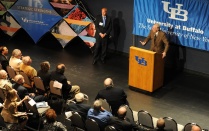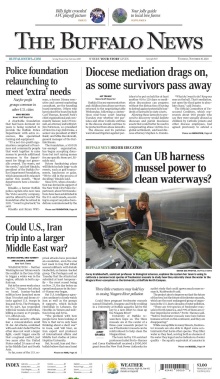Krabbenhoft Aquatic Ecology Lab testing how freshwater mussels may improve water quality of Niagara River

UB Researchers pictured standing, left to right: MS student Max Striedl, Research Technician Jonah Fronk, Dr. Corey Krabbenhoft, and Dr. Isabel Porto-Hannes. Their work began in July 2023 with the installation of water tanks at UB and an opportunity to collect gravid mussels from a local creek bed. Photo: Douglas Levere.
According to Dr. Corey Krabbenhoft (Department of Biological Sciences), “Freshwater mussels feed by filtering things like bacteria and contaminants out of the water. A great way to help our waterways become healthier is to invest in freshwater mussels." UB Research News published an article about the work of Krabbenhoft, and Dr. Isabel Porto-Hannes (Department of Environment and Sustainability). They are conducting a pilot study to determine if the water and sediment quality of the upper Niagara River is acceptable for a possible large-scale reintroduction of freshwater mussels to naturally clean the waterway. Read the article by Jackie Hausler
BUFFALO NEWS FRONT PAGE: Can UB harness mussel power to clean waterways?
research news
UB researchers study if freshwater mussels can clean Niagara River
Corey Krabbenhoft holds a large mussel from Ellicott Creek. Photo: Douglas Levere
By JACKIE HAUSLER
Published November 7, 2023
The Niagara River is a powerful force in Western New York, helping to supply electricity to areas throughout the entire state — and the fate of its water quality relies heavily on fish and their unassuming counterpart, freshwater mussels.
The Niagara River is considered an Area of Concern by the U.S. Environmental Protection Agency, as it has been degraded and contaminated from decades of humans not knowing the proper ways to interact with the environment — especially when it comes to industry, commerce and transportation. While the water quality has vastly improved over the past 50 to 60 years with legislation like the Clean Water Act, there’s more work to be done, and a possible solution is forming within water tanks in UB’s Hochstetter Hall.
Mussels are freshwater heroes — dubbed the “kidneys” of the waterways they occupy — but their populations have significantly plummeted in the Niagara River Basin over the years.
“Freshwater mussels feed by filtering things like bacteria and contaminants out of the water,” says Corey A. Krabbenhoft, assistant professor in the Department of Biological Sciences. “A great way to help our waterways become healthier is to invest in freshwater mussels. Their populations in our waterways are a great indicator of the water quality and the wildlife that inhabit it.”
The work began in July with the installation of water tanks at UB and an opportunity to collect gravid (pregnant) female mussels from a local creek bed. Photos: Douglas Levere
With a $500,000 grant from the New York State Power Authority Habitat Enhancement and Restoration Fund, Krabbenhoft, co-principal investigator, and Isabel Porto-Hannes (PI), principal investigator and teaching assistant professor in the Department of Environment and Sustainability, are conducting a pilot study to determine if the water and sediment quality of the upper Niagara River is acceptable for a possible large-scale reintroduction of freshwater mussels to naturally clean the waterway.
The work began in July with the installation of water tanks at UB and an opportunity to collect gravid (pregnant) female mussels from a local creek bed. The process will continue in the Krabbenhoft Aquatic Ecology Lab this winter, where one of nature’s wildest life history cycles will unfold.
The process for larvae to form into mussels requires interaction with fish. The mussel larvae start in the gills of the gravid mussel shells. In the wild, when water temperatures naturally warm in the spring, the mussel’s lure (a modified tissue that mussels can display outside their shell) mimics small fish or prey to attract larger fish. The larger fish come close to investigate a possible meal and the gravid mussel releases its larvae into the gills of the fish. The larvae attach, and after a couple of weeks of receiving nutrients from the fish, they are large enough (metamorphose) to drop off into the water on their own.
In the lab, the larvae will be manually extracted from the female mussels and placed into a container to infest the fish — in this case largemouth bass — for the attachment process. Jonah Fronk, a research technician, and Max Striedl, a master’s student in biological sciences, will assist Krabbenhoft and Porto-Hannes in daily water checks by sampling the water chemistry parameters, including PH, temperature and dissolved oxygen levels.
“In late spring, the juvenile mussels will be placed into the upper Niagara River so we can track their growth and survival through the summer,” Porto-Hannes explains. “They are very small at this point — we’re talking millimeters. They are going to be housed in a mussel silo, which consists of a cement dome containing a PVC chamber to monitor their growth and suitability of the habitat.”
At the end of next summer, the mussels will be counted and measured to determine the next phase of the study. The group plans to conduct adjacent mussel surveys, researching habitat constraints to help dig into details of additional research questions regarding mussel biology and their interactions with fish.
While the degradation of rivers occurs in freshwater systems all over the world and is not unique to Western New York, Krabbenhoft and Porto-Hannes say there are things we can all do to help our precious natural resources.
“Little things go a long way,” says Porto-Hannes. “Be aware of your environment; recycle and properly dispose of your garbage; be mindful of what you put down the drain; look closer at how you buy and use things. All these little efforts make a difference.
“Even if you aren’t near the lake and can’t see it from your house,” she says, “what you are doing will affect the watershed. Everything is connected.
“We don’t just live on the river; we live within the watershed.”
Faculty Profile
![Corey Krabbenhoft holds a fish sample inside her lab at UB. Her research found that fish diversity in arid regions of the U.S. and Australia dropped amid reduced water availability over the past four decades. Photo: Douglas Levere.]()
Corey A. Krabbenhoft
PhD
Assistant ProfessorResearch Interests
Aquatic ecology; Freshwater ecosystems; Fisheries
Education
- University of Minnesota, Postdoc
- Wayne State University, PhD
- University of New Mexico, BS, MS
Office Hours
By appointment
Research Summary
My research program is focused on aquatic ecology. I am interested in investigating aquatic community structure and function to help provide insight for designing monitoring strategies, understanding the causes and consequences of species loss, and contributing to conservation and management. My lab aims to understand existing aquatic communities, how they function, how they came to be, and how they will respond to future stressors. Our work harnesses traditional ecological data (e.g., water quality, habitat availability, assemblage diversity) from field, laboratory, and museum studies of freshwater systems to identify the ecological and environmental context relevant to aquatic community composition and function. We address questions about whether aquatic communities are constrained by anthropogenic activities and work to develop mitigation strategies for negative environmental impacts. My research speaks to current questions in ecology by addressing the ecological role of species at multiple life history stages, investigating the nature of species interactions and how they shape community structure (including invasion), and developing models to forecast how species distributions will be altered in changing environments.
Selected Publications
Krabbenhoft C.A., and D.R. Kashian. 2022. Invasion success of a freshwater fish corresponds to low dissolved oxygen and diminished riparian integrity. Biological Invasions, doi: 10.1007/s10530-022-02827-1.
Krabbenhoft C.A., G.H. Allen, P. Lin, S.E. Godsey, D.C. Allen, R.M. Burrows, A.G. DelVecchia, K.M. Fritz, M. Shanafield, A.J. Burgin, M.A. Zimmer, T. Datry, W.K. Dodds, C.N. Jones, M.C. Mims, C. Franklin, J.C. Hammond, S.C. Zipper, A.S. Ward, K.H. Costigan, H.E. Beck, and J.D. Olden. 2022. Assessing placement bias of the global gauge network. Nature Sustainability, 5: 586-592.
Hansen, G.J.A., J. Ruzich, C.A. Krabbenhoft, H. Kundel, S. Mahlum, C. Rounds, A. Van Pelt, L.D. Eslinger, D.E. Logsdon, and D.A. Isermann. 2022. It’s complicated and it depends: A review of the effects of ecosystem changes on walleye and yellow perch populations in North America.North American Journal of Fisheries Management, 42: 484-506.
Krabbenhoft C.A., and D.R. Kashian. 2020. Citizen science data are a reliable complement to quantitative ecological assessments in urban rivers. Ecological Indicators, 116: 106476.
Krabbenhoft C.A., A.S. Burdett, and T.F. Turner. 2017. Direct and indirect effects of predatory young-of-year fishes in a dryland river food web. Freshwater Biology, 62: 1410-1421.



